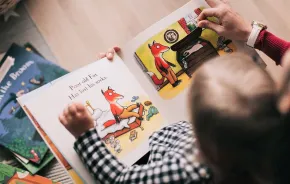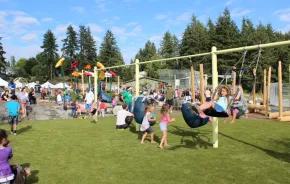
Photo:
Credit: Natasha Dillinger
With so many kids struggling with remote learning, families are looking outside of school for hands-on experiences. When I heard about the new ecotourism programs offered by the Duwamish Tribe in West Seattle, I jumped at the chance to go — an opportunity to learn about Seattle's first people, combined with science and time outdoors? Sign us up!
The Duwamish: land and water stewards to learn from
Our tour began at the Duwamish Longhouse in West Seattle where we found exhibits filled with photos of Duwamish people and examples of traditional canoes and tools. This is the only indoor part of the experience. A one-way circuit marked with Sasquatch footprints aids social distancing as you go through. My kids loved listening to tribal members speaking Southern Lushootseed, the language of the Duwamish people.

Our tour guide, Andrew, helped us brave the traffic to cross Marginal Way from the Longhouse to Herring’s House Park. A restoration ecologist by training, Andrew used a waterlines map compiled by the Burke Museum and the University of Washington to show us how the land and waterways around the Duwamish River have been reshaped. From various lookout points along the trail, we could see the changes he pointed out. Industrial pollution of the Lower Duwamish Waterway has led to its designation as a Superfund site by the EPA, which makes it eligible for federal cleanup funding.
One of the things that stood out to me during the tour was the interconnection between the exclusion of the Duwamish people and the degradation of the land and river. Non-Native industry leaders and local officials sought to limit seasonal flooding and facilitate large ship travel through local waterways. Interventions such as straightening the Duwamish River and digging the Montlake Cut led to the filling in of natural tideflats and wetlands, lowering Lake Washington’s level by nine feet and drying up the Black River.

While the 1855 Treaty of Point Elliott should have protected the fishing rights of signatory tribes, these significant waterway alterations wiped out many traditional sources of shellfish and salmon for the Duwamish — not to mention resident orcas and other marine animals. The lack of seasonal food abundance also limited the ability of tribes to gather in large groups, effectively restricting their ability to use collective bargaining to resist treaty violations.
Spotting history
From our tour's vantage points along the Duwamish River, we could see the location of the X̌əʔapus (pronounced "ha’-ah-poos") Village, which was burned down in the late 1800s to make room for settler housing.
Duwamish people traditionally used fire in more constructive ways. Seasonal burning of nearby prairie grasses not only prevented larger fires, but also limited weeds and provided nutrients for crops like camas and strawberries. Andrew told us that the slow-cooked cama roots taste like baked pears, so my kids have a new snack food they’re asking for!

A tour for everyone
The Tribe currently offers two options for its outdoor ecotours. The X̌əʔapus Village and Shoreline Habitat Tour, the one we took, centers on the cultural and political history of the Duwamish and the changes in the lands they steward. The West Duwamish Greenbelt Tour and Workshop has a stronger focus on the historic pollution and logging in the area, and efforts to restore the local ecosystem.
While both tours seemed geared toward older kids and adults, the coordinator had no qualms about encouraging me to bring my young kids (almost 5 and 2 years old) and was welcoming during the tour itself.
I also appreciated the scheduling flexibility. The tours are a new offering and families can request a tour anytime during the Duwamish Longhouse open hours, currently Tuesday–Saturday, 10 a.m.–5 p.m. We picked a weekday morning to avoid nap times and weekend crowds at local parks.
Masks and social distancing are required throughout the tour. Hand sanitizer and restrooms for hand washing are available at the Longhouse.

Age recommendation
Based on our experience, I would recommend the tour for families with elementary-aged kids and older, or families with young children who will play nearby while parents do more active listening. Taking the time to learn about the Duwamish people and their history shows that we value their past and present contributions to Seattle.
I would love to tell you that my young kids listened with rapt attention to Andrew’s knowledgeable discussion about local ecology and pollution. However, it was a beautiful sunny day and they were most interested in ogling the wildlife that has started to return to the Duwamish River (we spotted a seal!) and throwing rocks into the water as we looked at the remains of the “Longhouse compost pile” — layers of clam shells embedded in the shoreline near the village site.
Part of this might have been because a slight scheduling snafu meant we joined a group of four adults rather than having a private tour. Understandably, the conversation focused on higher-level topics and the walking pace between stops was fast for an ambling pre-kindergartner and toddler.
Even with younger kids in tow, I was able to absorb a lot of information that I could distill into more manageable chunks for them later. Our dinner conversation that night focused on what we can learn from cultures with more experience appreciating and caring for our environment. Overall, the tour was an easy win: extra outside time in an area we might not otherwise have visited and the opportunity to learn real-life lessons in history, culture and science.
If you go...Find it: Tours meet at the Duwamish Longhouse at 4705 West Marginal Way S.W. in West Seattle. Hours: Book your ecotour in advance through the Duwamish website’s contact form, and expect a response within about a week. Families can state a preference for a tour during the Longhouse opening hours, which are Tuesday–Saturday from 10 a.m.–5 p.m. Our tour lasted 2 hours. Cost: A donation of $10–$25 per person is recommended, but no one will be turned away if there is availability. Group requirements and safety protocols: Tour size is limited to 11 people during the pandemic and a waiver for each participant is required. Visitors are asked to sign a log for contact tracing. Masks and social distancing are required throughout the tour. Facilities: Free parking is available at the Longhouse and at Herring’s House Park across the street. Restrooms and hand sanitizer are available inside the Longhouse. Future tour opportunities: While only walking tours are currently offered, plans are in the works for kayaking, canoeing and biking tours. The easiest way to get updates is to follow the Duwamish Tribe on Instagram (@duwamishtribe). More nearby: Extend your outdoor fun at the Seattle Chinese Garden on the South Seattle College campus or bring bikes to enjoy the White Center Bike Playground. For a travel experience without the plane, pick up lunch and treats at the Salvadorean Bakery in White Center. Not ready for a group tour? Here are some opportunities for learning at home and supporting the DuwamishDuwamish-specific resources:
Self-guided tours: The Duwamish trail across from the Longhouse has interpretive signs for families who want a self-guided tour. You can also check out the tours on the reverse side of the Burke’s waterlines map to learn more about the Indigenous roots of local natural landmarks. HistoryLink.org: Find more information on settler waterway interventions, learn about the straightening of the Duwamish River and construction of the Montlake Cut. Burke Museum curriculum packets: The Burke Museum supports families and educators with free downloadable curriculum packets that highlight Indigenous culture (both traditional and contemporary) in areas like food, fish and storytelling. |











